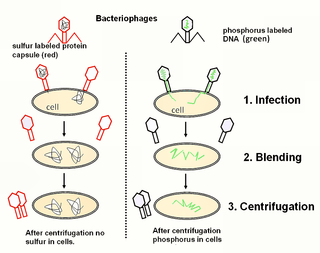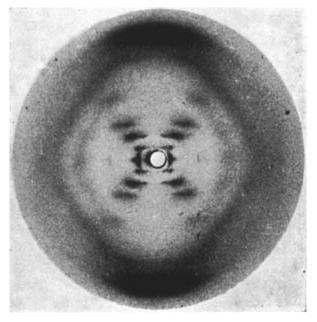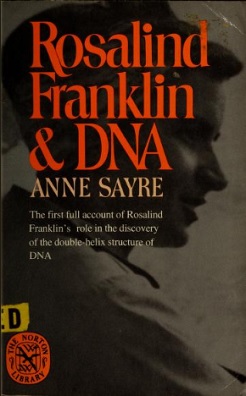
Francis Harry Compton Crick was an English molecular biologist, biophysicist, and neuroscientist. He, James Watson, Rosalind Franklin, and Maurice Wilkins played crucial roles in deciphering the helical structure of the DNA molecule. Crick and Watson's paper in Nature in 1953 laid the groundwork for understanding DNA structure and functions. Together with Maurice Wilkins, they were jointly awarded the 1962 Nobel Prize in Physiology or Medicine "for their discoveries concerning the molecular structure of nucleic acids and its significance for information transfer in living material".

The Hershey–Chase experiments were a series of experiments conducted in 1952 by Alfred Hershey and Martha Chase that helped to confirm that DNA is genetic material.

James Dewey Watson is an American molecular biologist, geneticist, and zoologist. In 1953, he co-authored with Francis Crick the academic paper proposing the double helix structure of the DNA molecule. Watson, Crick and Maurice Wilkins were awarded the 1962 Nobel Prize in Physiology or Medicine "for their discoveries concerning the molecular structure of nucleic acids and its significance for information transfer in living material". In subsequent years, it has been recognized that Watson and his colleagues did not properly attribute colleague Rosalind Franklin for her contributions to the discovery of the double helix structure.

Rosalind Elsie Franklin was a British chemist and X-ray crystallographer whose work was central to the understanding of the molecular structures of DNA, RNA, viruses, coal, and graphite. Although her works on coal and viruses were appreciated in her lifetime, Franklin’s contributions to the discovery of the structure of DNA were largely unrecognized during her life, for which she has been variously referred to as the "wronged heroine", the "dark lady of DNA", the "forgotten heroine", a "feminist icon", and the "Sylvia Plath of molecular biology".

The Cavendish Laboratory is the Department of Physics at the University of Cambridge, and is part of the School of Physical Sciences. The laboratory was opened in 1874 on the New Museums Site as a laboratory for experimental physics and is named after the British chemist and physicist Henry Cavendish. The laboratory has had a huge influence on research in the disciplines of physics and biology.

Maurice Hugh Frederick Wilkins was a New Zealand-born British biophysicist and Nobel laureate whose research spanned multiple areas of physics and biophysics, contributing to the scientific understanding of phosphorescence, isotope separation, optical microscopy and X-ray diffraction, and to the development of radar. He is known for his work at King's College London on the structure of DNA.

Sir William Lawrence Bragg, was an Australian-born British physicist and X-ray crystallographer, discoverer (1912) of Bragg's law of X-ray diffraction, which is basic for the determination of crystal structure. He was joint recipient of the Nobel Prize in Physics in 1915, "For their services in the analysis of crystal structure by means of X-rays"; an important step in the development of X-ray crystallography.
The year 1953 involved numerous significant events in science and technology, including the first description of the DNA double helix, the discovery of neutrinos, and the release of the first polio vaccine.

The Double Helix: A Personal Account of the Discovery of the Structure of DNA is an autobiographical account of the discovery of the double helix structure of DNA written by James D. Watson and published in 1968. It has earned both critical and public praise, along with continuing controversy about credit for the Nobel award and attitudes towards female scientists at the time of the discovery.

Varsity is the oldest of Cambridge University's main student newspapers. It has been published continuously since 1947 and is one of only three fully independent student newspapers in the UK. It moved back to being a weekly publication in Michaelmas 2015, and is published every Friday during term time.

"Molecular Structure of Nucleic Acids: A Structure for Deoxyribose Nucleic Acid" was the first article published to describe the discovery of the double helix structure of DNA, using X-ray diffraction and the mathematics of a helix transform. It was published by Francis Crick and James D. Watson in the scientific journal Nature on pages 737–738 of its 171st volume.

Herbert Rees Wilson FRSE was a physicist, who was one of the team who worked on the structure of DNA at King's College London, under the direction of Sir John Randall.
Alexander Rawson Stokes was a British physicist at Royal Holloway College, London and later at King's College London. He was most recognised as a co-author of the second of the three papers published sequentially in Nature on 25 April 1953 describing the correct molecular structure of DNA. The first was authored by Francis Crick and James Watson, and the third by Rosalind Franklin and Raymond Gosling.
The history of molecular biology begins in the 1930s with the convergence of various, previously distinct biological and physical disciplines: biochemistry, genetics, microbiology, virology and physics. With the hope of understanding life at its most fundamental level, numerous physicists and chemists also took an interest in what would become molecular biology.
Robert Cecil Olby was a research professor in the Department of History and Philosophy of Science at the University of Pittsburgh. Formerly Reader at the University of Leeds, UK, Robert Olby is a historian of 19th and 20th century biology, his specialist fields being genetics and molecular biology. With the assistance of Martin Packer, Olby completed an authorized biography of the late Francis Crick. It is entitled Francis Crick: Hunter of Life's Secrets, after an article in The New York Times on February 2, 1962.

Photo 51 is an X-ray based fiber diffraction image of a paracrystalline gel composed of DNA fiber taken by Raymond Gosling, a graduate student working under the supervision of Rosalind Franklin in May 1952 at King's College London, while working in Sir John Randall's group. The image was tagged "photo 51" because it was the 51st diffraction photograph that Franklin and Gosling had taken. It was critical evidence in identifying the structure of DNA.

Molecular models of DNA structures are representations of the molecular geometry and topology of deoxyribonucleic acid (DNA) molecules using one of several means, with the aim of simplifying and presenting the essential, physical and chemical, properties of DNA molecular structures either in vivo or in vitro. These representations include closely packed spheres made of plastic, metal wires for skeletal models, graphic computations and animations by computers, artistic rendering. Computer molecular models also allow animations and molecular dynamics simulations that are very important for understanding how DNA functions in vivo.
What Mad Pursuit: A Personal View of Scientific Discovery is a book published in 1988 and written by Francis Crick, the English co-discoverer in 1953 of the structure of DNA. In this book, Crick gives important insights into his work on the DNA structure, along with the Central Dogma of molecular biology and the genetic code, and his later work on neuroscience.

Rosalind Franklin and DNA is a biography of an English chemist Rosalind Franklin (1920–1958) written by her American friend Anne Sayre in 1975. Franklin was a physical chemist who made pivotal research in the discovery of the structure of DNA, known as "the most important discovery" in biology. DNA itself had become "life's most famous molecule". While working at the King's College London in 1951, she discovered two types of DNA called A-DNA and B-DNA. Her X-ray images of DNA indicated helical structure. Her X-ray image of B-DNA taken in 1952 became the best evidence for the structure of DNA. For the discovery of the correct chemical structure of DNA, the Nobel Prize in Physiology or Medicine 1962 was shared by her colleagues and close researchers James Watson, Francis Crick and Maurice Wilkins; she had died four years earlier in 1958 making her ineligible for the award.
DNA: The Story of Life is a four-part Channel 4 documentary series on the discovery of DNA, broadcast in 2003.













